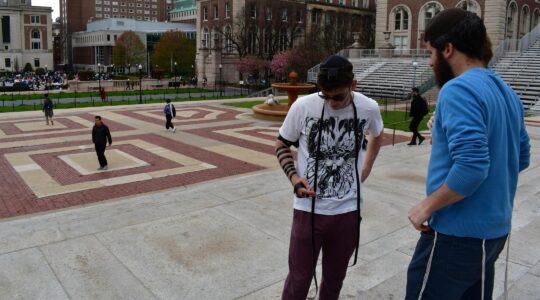REFORM
Number: Unknown, but at least 800-900 per year. The American Jewish Archives in Cincinnati keeps a record of conversion certificates but does not know what proportion of converts send them in. The Union for Reform Judaism says over 1,000 individuals took one of its 16-week conversion classes in 2013.
Ritual: Varies. All “Jews by choice” make some kind of public declaration of commitment. It may be in the rabbi’s office before a three-person religious panel, in front of the entire congregation in the synagogue sanctuary or at the mikvah. Mikvah immersion is recommended but not required. Some men also undergo circumcision or the symbolic drawing of blood, but it’s not required. In synagogue conversion ceremonies, the convert typically holds the Torah, recites the Shema, is given a Hebrew name and receives a blessing.

Caroline Potter, in blue shirt with triangles, celebrating with family, friends and clergy from Temple Sinai, a Reform synagogue in Brookline, Mass., after her conversion ceremony, Aug. 1, 2014. (Mayyim Hayyim)
Preparation: A 14- to 16-week Introduction to Judaism class that meets weekly and covers such topics as basic Hebrew and prayer, holidays, Jewish history, Jewish lifecycle, Israel and how-to Judaism. These may be supplemented or substituted by individualized counseling or study sessions with rabbis.
Requirements: Broadly speaking, commitment to the Jewish people, living life as a Jew and Jewish values. Some ceremonies require affirmation of six key tenets as outlined in the conversion service published by the movement in 1988: accepting Judaism to the exclusion of all other religious; freely entering the covenant between God and the Jewish people; being loyal to Judaism and the Jewish people; establishing a Jewish home and participating actively in synagogue and communal life; pursuing Torah and Jewish knowledge; raising one’s children as Jews.
Who’s converting? Longtime non-Jewish spouses of Jews who may have raised Jewish children and long been involved in synagogue life and now want to formalize their Jewish identity; gentiles marrying Jews; spiritual seekers.
Feeling toward conversions performed by other denominations: If you have chosen to become a Jew and gone through some kind of legitimate conversion, you’re Jewish.
Problems: If you’re applying for Israeli citizenship, Reform conversions usually pass muster with the Israeli Interior Ministry but not with the Orthodox-dominated Israeli Chief Rabbinate. That means you can move to Israel but you can’t marry a Jew there. In the United States, too, Orthodox institutions don’t accept Reform conversions. Your conversion probably won’t count according to Conservative interpretations of Jewish law, either, but that depends on the specifics of your conversion and which Conservative rabbi you ask.
Who is a Jew without conversion: Anyone with a Jewish parent (mother or father) living as a Jew. Someone with a Jewish parent who identifies with another faith is not considered Jewish.
(This piece does not include conversion by other denominations or no denomination because the numbers are negligible compared with the three main American Jewish religious denominations.)
Read 10 questions about Jewish conversion you want to know but are afraid to ask.





